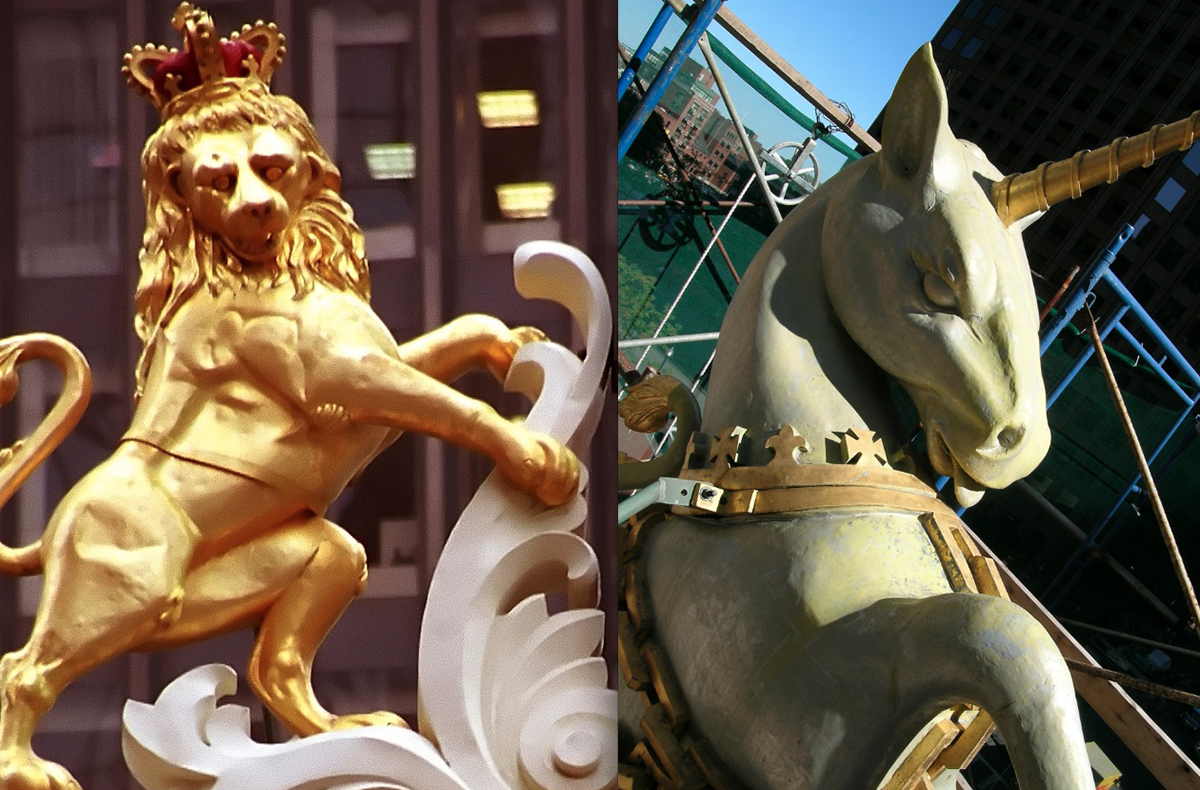Old State House Statues Shipping Off to Woburn Studio for Restorations

Images Courtesy of David Ohmer on Flickr/Bostonian Society
It takes a very steady hand, complete silence, and a room that’s void of even the slightest bit of wind. But the job is a rewarding one; and it’s something that Bob Shure has learned to master in his own way.
On September 14, the lion and unicorn that sit valiantly atop the Old State House in Downtown Boston, the oldest surviving public building in the city’s history, which dates back to before the American Revolution, will be coming down for some much-needed restorations.
And when they do, they’ll be shipped off to Shure’s headquarters in Woburn, Skylight Studios, where the professional sculptor will meticulously apply by hand special gold and silver coatings to each individual statue, so that when they go back up in the next few months, they will glimmer when the sun shines down State Street, hitting the crown resting on the lion’s mane, and bouncing off the horn protruding from the unicorn’s forehead.
“It’s a very tedious process, and it’s very important to get it very precise,” said Shure, who has been doing restoration work and sculpture design since the 1970s. “But [the process] hasn’t changed in centuries.”
Shure is familiar with the lion and unicorn, which he describes as classic “icons.” Although it was believed that the unicorn and lion hadn’t been touched since the country’s bicentennial celebrations in 1976, Shure said in the 1990s his studio in Woburn was responsible for a similar restoration process to the one that’s scheduled to take place in the coming weeks. During that time, Shure had to put in a little extra work that required additional rebuilding of the ancient structures, two life-sized replicas of the original relics that were placed on the Old State House back in 1713.
“Before they needed major help, they were just falling apart. It was a great experience but a huge challenge,” he said.
Since he only needs to focus on reguilding the pieces of artwork this time around, rather than fill gaps and molds that chipped away due to the harsh weather elements, he imagines the process won’t take too long. But it’s still an arduous one.
“Hopefully this time it will be a lot easier because it will be surface work instead of structural work,” said Shure. “But you need a lot of patience, and a steady hand,” especially to get in every crack and crevice.
Shure said once he has the statues in his possession—the Bostonian Society, the non-profit group that’s responsible for maintaining the Old State House is waiting for the OK from the city to remove the statues— he will first strip them of their current coatings. The lion has a thin film of 24-carat gold that covers it’s exterior, which has slowly begun to fade since it’s last restoration 24 years ago. The unicorn, which is the size of an actual horse, shimmers with a silverish tone, will now be reguilded with a coating of palladium, so it can stand up to the wind, rain, and snow without the risk of deterioration.
Once cleaned of their current layers, the hollow copper statues will be re-coated with primer.
“It’s just like when priming a house, it’s a special metal primer that goes over the metal,” said Shure.
From there, a sticky varnish is applied to the statues, which acts an adhesive that will vacuum the sheets of silver and gold from a special brush used by Shure onto the surfaces of the molds.
That’s the tricky part.
Both the gold and palladium that cover the statues come in individual sheets that are roughly the size of Post-it notes, or a square of tinfoil, said Shure. Sheet-by-sheet, Shure uses a brush known as a “guilder’s tip” to move them onto the sculptures. The transfer process is one that can’t be interrupted, and requires complete focus.
“The most important thing is to do it in a place where there is absolutely no wind. That’s the enemy of gold leaf. One little gust of wind—that gold is expensive,” said Shure, adding that the palladium sometimes costs even more. “You could waste a lot of it by accident. You want to do it in an area that, you know, is kind of still, without a lot of people walking back and forth.”
To get the gold and palladium strips to stick to his guilder’s tip, it’s not as easy as just attaching the two together. Shure said he first has to rely on a technique that is unique to his style. Taking the tip—which is like a paint brush—he rubs it on his clothing to generate static electricity. Relying on the electric current, he floats the brush above the gold or silver strips, and lets them connect organically, applying the squares, one bit at a time, almost like a puzzle.
Then he waits to hear a “snap.” That means the sticky varnish has suctioned the strip onto the surface, and the effort was a success.
“If you don’t hear the snap, it means it’s too wet, and it didn’t work. You need complete silence and isolation [to hear it],” said Shure. “When it dries, it dries totally dry, and then you just buff it.”
And then the statues will go back to Boston, and sit once again on their perch above the city’s historic district, serving as one of the most popular spot where tourists take photos.
“It’s a really cool process,” said Shure.


